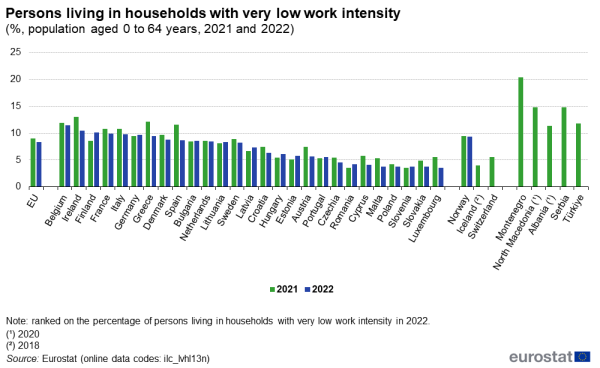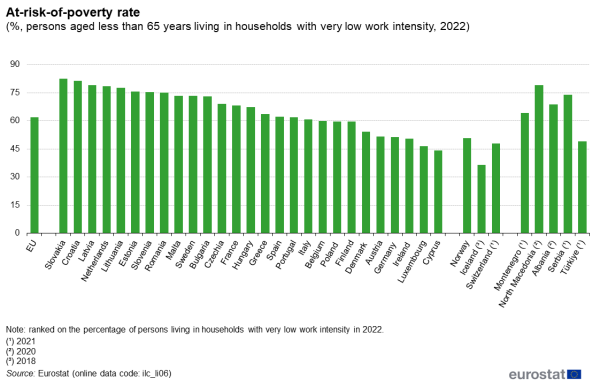Living conditions in Europe - work intensity
Data extracted in October 2023.
Planned article update: November 2024.
Highlights
In 2022, 8.3 % or 27.2 million people of the EU population aged less than 65 years lived in households with very low work intensity.
In 2022, 61.9 % of the EU population aged less than 65 years living in households with very low work intensity were at risk of poverty.
Significant regional disparities in very low work intensity rates were recorded in Spain, France, Belgium, Italy, Germany, and Bulgaria, in 2022.
This article focuses on the population aged less than 65 years living in households with very low work intensity within the European Union (EU) in 2022. The analysis is carried out over time, at national and regional levels and considering the poverty level as well as households' composition.
All figures are based on EU statistics on income and living conditions (EU-SILC) available from Eurostat's online database. EU-SILC data are available for all EU Member States, as well as for most of the EFTA and candidate countries.
Full article
Key findings
In 2022, 8.3 % of the EU population aged less than 65 years lived in households with very low work intensity, a decrease from 9 % in 2021. Belgium reported the highest rate (11.5 %), and Luxembourg the lowest (3.5 %).
Significant inter-regional disparities within EU Member States were observed in 2022, with some regions showing differences in very low work intensity rates exceeding 10 percentage points (pp).
The at-risk-of-poverty rate for individuals in households with very low work intensity stood at 61.9 %, with Slovakia and Croatia reporting the highest rates.
In 2022, the share of the EU population aged less than 65 years living in households with very low work-intensity was 6.7 % for households with dependent children, compared with 11.1 % for households without dependent children. This difference was particularly evident in Denmark and Greece.
Low work intensity
The work intensity of a household is the ratio of the total number of months that adults household members (as defined in the context section) have worked during the income reference year and the total number of months the same household members theoretically could have worked in the same period. It is defined in levels, ranging from very low (household working time was equal to or less than 20 % of the full potential) to very high (working time was more than 85 % of the full potential).
Generally, the higher the work intensity within a household (the closer people are to full employment), the lower the probability of being at-risk-of-poverty.
Very low work intensity in 2022 highest in Belgium and lowest Luxembourg
In 2022, 8.3 % of the EU population aged less than 65 years lived in household with very low work intensity (see Figure 1). This percentage ranged from below 4.0 % in Slovakia, Slovenia, Poland, Malta (all four at 3.8 %) and Luxembourg (3.5 %) to above 10.0 % in Finland (10.1 %), Ireland (10.5 %) and Belgium (11.5 %).
Figure 1 shows that in 2022, the percentage of the EU population aged less than 65 years living in household with very low work intensity was 0.7 pp lower than in 2021, decreasing from 9 % to 8.3 %. The largest decreases were observed in Spain (2.9 pp), Greece (2.6 pp) and Ireland (2.5 pp). Increases were observed in 10 EU member states especially in Finland (1.5 pp), Hungary, Estonia and Romania (all at 0.7 pp).

(%)
Source: Eurostat (ilc_lvhl13n)
Lowest inter-regional disparities in very low work intensity rates in Sweden, Denmark, Lithuania, Finland and Ireland
Map 1 illustrates the share of the EU population aged less than 65 years living in households characterized by very low work intensity at the NUTS level 2 in 2022. Among all EU regions, Guyane and Ciudad de Ceuta reported the highest regional share of the population aged less than 65 years living in households with very low work intensity, with more than 25 % of the population facing such conditions.
In addition, several other regions within the EU reported elevated rates of very low work intensity, exceeding 18.5 %. These regions were located across Spain, France, Belgium, Italy, Germany and Bulgaria. Conversely, all regions in Portugal, Spain, Italy, Belgium, Germany, Czechia, Croatia, Austria, Hungary, Slovenia, Slovakia, Poland, Bulgaria and Romania had a share below 5.0 %.
Significant inter-regional disparities in very low work intensity rates were observed in Spain, France, Belgium, Italy, Germany, and Bulgaria. The variation between the highest and lowest rates within these EU Member States exceeded 10 pp. By contrast, in Sweden, Denmark, Lithuania, Finland, Ireland, and Slovenia, inter-regional differences were less than 4.5 pp.

Source: Eurostat (ilc_lvhl13n) and (ilc_lvhl21n)
Significant variation in at-risk-of-poverty rates among EU households with very low work intensity
In the EU, the at-risk-of-poverty rate for people aged less than 65 years living in households with very low work intensity stood at 61.9 % in 2022. Seventeen EU Member States reported at-risk-of-poverty rates above the EU average, with the highest values observed in Slovakia at 82.6 %,Croatia at 81.4 % and Latvia at 79.0 %. Conversely, the lowest rates were recorded in Luxembourg (46.4 %) and Cyprus (44.3 %), as shown in Figure 2.

(%)
Source: Eurostat (ilc_li06)
Very low work intensity rates higher among people living in households without dependent children
In 2022, the proportion of the EU population aged less than 65 years living in very low work-intensity households was 6.7 % for households with dependent children, compared with 11.1 % for households without dependent children, reflecting a difference of 4.4 pp, as shown in Figure 3.
The presence of dependent children had a particularly large impact on the share of the population living in households with very low work intensity in Denmark and Greece: rates were respectively 11.2 pp and 9.5 pp lower for people living in households with dependent children. Bulgaria and Slovakia were the only EU Member States where the rate was higher for households with dependent children, with a difference of 0.6 pp and 0.3 pp, respectively.

(%)
Source: Eurostat (ilc_lvhl13n)
Source data for tables and graphs
Data sources
The data used in this article are derived from EU statistics on income and living conditions (EU-SILC). EU-SILC data are compiled annually and are the main source of statistics that measure income and living conditions in Europe. It is also the main source of information used to link different aspects relating to the quality of life of households and individuals.
The reference population for the information presented in this article is all private households and their current members residing in the territory of an EU Member State (or non-EU member country) at the time of data collection. Persons living in collective households are generally excluded from the target population. The data for the EU are population-weighted averages of national data.
Context
The work intensity of a household is the ratio of the total number of months that all adults household members have worked during the income reference year and the total number of months the same household members theoretically could have worked in the same period. 'Adults' refers to people aged 18 to 64 years. Students aged 18 to 24 years; people who are retired according to their self-defined current economic status or who receive any pension (except survivor's pension); and people in the age bracket 60 to 64 years who are inactive and living in a household where the main income is pensions, are not taken into account. Work intensity is considered very low when the adults of the household had a working time equal to or less than 20 % of their total combined work-time potential during the previous year. By contrast, work intensity is considered very high when the adults of the household had a working time more than 85 % of their total combined work-time potential.
The low work intensity indicator (LWI) is part of the at risk of poverty or social exclusion rate defined in the framework of the EU 2030 target on poverty and social exclusion (AROPE). The AROPE ratio is the share of the total population which is at risk of poverty or social exclusion. The headline target (EU2030 target) on poverty and social inclusion of the European Pillar of Social Rights Action Plan is to reduce the number of people at risk of poverty or social exclusion by at least 15 million by 2030. Progress towards this target is monitored through the AROPE rate, published by Eurostat.
Direct access to